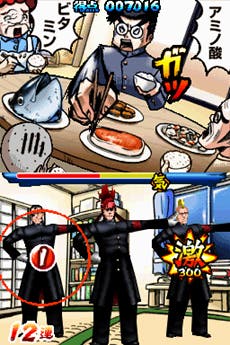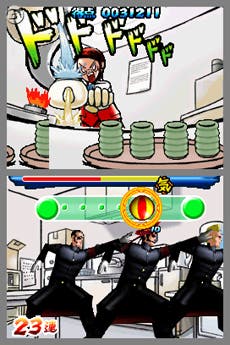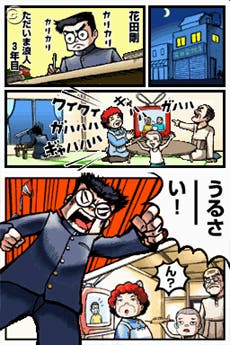Osu! Tatakae! Ouendan
Brilliant rhythm-action from the Gitaroo Man folks.
The problem with cheerleaders (apart from eating disorders, low IQs and other Saved By The Bell stereotypes we're lazily appropriating for these parentheses) is that their obvious aesthetic qualities can be overpowering. The motivational benefits of lithe, blonde, pompom-wielding acrobats are better measured in the crotch area than the cranial cavity. It's certainly our excuse for being rubbish at basketball and, thanks to the finely balanced televisual marketing equation of "product + woman = sale", the reason we're writing this in the early hours of the morning and not earlier, when we'd set aside time. It's bad enough trying to get anything written with neighbouring curtains, cushions and biros throwing shapes in the dancehalls of our eyes; introduce dancing girls to our periphery vision and the two would get on so well they'd probably elope, leaving us with tunnel vision, a lingering sense of inadequacy and an impending deadline.
Now, three blokes in long coats shouting and doing what appears to be some manner of hopscotch: that gets our fingers firing.
Osu! Tatakae! Ouendan is about cheerleading. In a town of problems, these chaps can always be called upon to help you through. Whatever you're having trouble with, a quick shout of "Ooooueeendaaan!" is all it takes and they're there. As their masters, it's our job to tap little icons on the screen in time to the J-Rock soundtrack without missing too many beats.
Okay, so it's a rhythm-action game. The DS didn't have one of those, but now it does - and with excellent pedigree, too. iNiS, the fellows who made this, previously worked on the under-appreciated Gitaroo Man for PS2, and this Nintendo-backed follow-up is every bit as beguiling as that by many accounts.

The object, as we said, is to match symbols - but also movements. For the sake of easing the ongoing definition, most musical pad-based rhythm-action games can be lumped into a "rhythm-response" sub-category - icons float past on the screen and you respond to them with the stab of a certain button. In games like Mad Maestro, and (quick, pick something popular) Britney's Dance Beat, you just have to match the prompts with X or square or something. Ouendan is closer in spirit to games like Harmonix' excellent FreQuency and Amplitude or the Konami Dance Dance/Dancing Stage series in that you are prompted to do certain things, but you have to move to some extent to respond correctly.
In Ouendan, little circles appear with numbers, and each has a larger ring gradually shrinking around it. When this ring closes to the outline of the circle, it coincides with a point in the music ideally suited for tapping the icon. Do this and it makes a noise - usually the sound of a cymbal or a whistle-like response. As the tune plays out, more circles with numbers appear one by one in more complex patterns, and the rings close in faster, so you have to wield your stylus expertly and with a degree of restraint to hit them all at the right moment - particularly when it starts teasing you with more complex stylus-movement patterns, slower-closing rings and the other evil things it does. Time it perfectly and you get 300 points; about right 100 points; poorly 50 points; and if you totally miss you don't get anything, and a meter along the top of the screen loses a bit of its juice.
Sometimes a circle appears inside a banana shape with a blank circle at the other end, and the idea is to tap as the ring closes and then drag the stylus along the arc as a little ball rolls from circle to circle, matching its movement. Sometimes it comes back. Sometimes the path is a more complex squiggle, perhaps even a spiral, and the ball rolls back and forth a few times. Used in concert with clever arrangements of normal numbered circles it can become maddening. No, wait, what's the other one? Genius.

But of course it can't become random. Doing that would be too much, so instead iNiS has matched each level to one of 15 J-Rock songs on the soundtrack - fairly popular ones, apparently, albeit performed by soundalikes - and like all good rhythm-response and rhythm-action games patterns emerge. Early levels demand simple motions - tapping the corners of a square of circles one by one, then moving to a different area of the screen to do the same, perhaps. Later though, you might have to double-tap a single icon as two rings close on it, quickly tap two more on a stylus-journey down the screen, slow your responses to half-tempo to catch the next two slower circles/rings, guide a ball half an inch, quickly dart over five circles arranged like stepping stones up the screen, guide another ball, then repeat the same sequence upside down to follow the next few bars of the song. Completing one of these sequences with expert timing will take much practice - and doing so can be as demanding and rewarding as navigating a FreQuency or Amplitude level by perfectly striking each icon and then switching rails in a split-second to amass a top score.
Where Ouendan seems to let itself down slightly is in the journey from those first stumbling steps to the intensity and precision of the latter stages. The satisfaction of becoming very good at it is huge, but the difficulty curves upward steeply after an initial run of relatively easy levels, and if your hand-eye coordination isn't up to snuff and you haven't been brought up on similar games you may get stuck in the early stages for longer than ideal.
Also, the need to pay close attention to the speed of the closing rings demands more replay time than it would otherwise. It's a good system and we appreciate it, but it means that the type of instinctive reaction familiar to fans of FreQuency or Amplitude, where your fingers seem to respond faster than your brain registers the game's next choice of icon, can be a longer time coming. Locating the icon and matching the song timing becomes an unconscious act, but when the game tricks you with a slower closing circle it can throw you off - and like most rhythm-anything games, once you miss a beat it's very hard to get back into it without restarting.

But, besides that, our concerns are relatively few. Sometimes your hand naturally obscures the screen, but you can learn to make allowances for that, and the use of end-of-section turntable bits that involve spinning a disc as vigorously as possible seem out of place and needlessly difficult. Fortunately they're not used all that often.
All of this is to say nothing of the visual and audio quality. The screenshots, thankfully, tell their own story - with comical intro sequences borne out panel by panel across both screens through some delightful Manga-style artwork that we'd love to print out and plaster all over our work area. But the audio, while slightly tinny through the DS speakers, is a revelation - there are 15 tracks on here to our knowledge, and, like Nintendo's Electroplankton, the quality of the music is amazing considering the amount of memory available to store it.
Since it arrived, Ouendan has commanded its place in our game-card slot with real urgency, and we've found ourselves reaching for it at every available opportunity. It's not likely to be a game you'll travel with - the need to be precise obviously rules it out of contention unless you're on a plane or something - but it is a game that any self-respecting DS-owning music game fan must acquire, and replaying old tunes to build up big scores with a succession of masterful strokes is a skill that you'll want to reaffirm as often as you do in its genre-rivals on other platforms.
It seems unlikely that it will cross the oceans in this form - particularly given the licensed Japanese soundtrack - but it's perfectly playable in untranslated form. Indeed, it's denied the honour of an import review score only by our caution - as we haven't been able to try the multiplayer mode, and our lack of Japanese language skills means we haven't worked out whether the non-linear level-selector is actually prompting us to play in a certain order, which would doubtless inform our views on the difficulty curve differently. If we did score it, it seems obvious what we'd give it though: three cheers.
Osu! Tatakae! Ouendan is available for the Nintendo DS in Japan only. You can download a video of it (4MB) from Eurofiles. Ask your usual importer for details.

